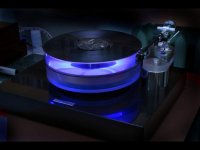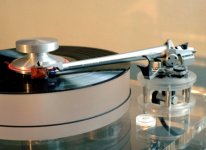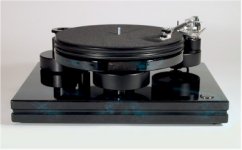Hello everyone,
My Scheu bearing and platter finally arrived, couldn't wait for the official plinth to be finished, so i put it all on a piece of wood, just to get a first impression. Arm comes from my Pro-ject RPM 4. Results so far are quite stunning, never knew there was so much on my records!😱
This is just a short impression, I'll get back when I've made a decent plinth..
My Scheu bearing and platter finally arrived, couldn't wait for the official plinth to be finished, so i put it all on a piece of wood, just to get a first impression. Arm comes from my Pro-ject RPM 4. Results so far are quite stunning, never knew there was so much on my records!😱
This is just a short impression, I'll get back when I've made a decent plinth..
Attachments
Looking good Miniwatt
Hi Miniwatt,
What type of motor are you using?
What kind of plint are you making? Granite? Wood or Plexiglas?
This looks nice already, wonder how it will look when finished!
Cheers,
Audiofanatic 😉Mooi Man!
Edit: BTW, I see that you have great (audio) taste, V.Medevoort amp and TEAC 😀
Hi Miniwatt,
What type of motor are you using?
What kind of plint are you making? Granite? Wood or Plexiglas?
This looks nice already, wonder how it will look when finished!
Cheers,
Audiofanatic 😉Mooi Man!
Edit: BTW, I see that you have great (audio) taste, V.Medevoort amp and TEAC 😀

Bedankt Audiofanatic / Thanks Audiofanatic😀
It's pretty much all Scheu, including the motor; DC, very powerful.
All of those!!🙂 Not really, plans are : top layer of acrylic, then a few layers of Birch plywood with cavities for sand, and maybe a bottom layer of aluminum -not shure about that one.
And a Ladegaard arm in the end...
🙂 🙂 🙂 Cheers!!
The Van Medevoort preamp is to be substituted by a Triode Dick's 6072 line amp / Phonodude. I think this will be a nice upgrade too... ("Where will it all end????")
The TEAC is my last CD-player I'll buy, can't get any better
What type of motor are you using?
It's pretty much all Scheu, including the motor; DC, very powerful.
What kind of plint are you making? Granite? Wood or Plexiglas?
All of those!!🙂 Not really, plans are : top layer of acrylic, then a few layers of Birch plywood with cavities for sand, and maybe a bottom layer of aluminum -not shure about that one.
And a Ladegaard arm in the end...
Edit: BTW, I see that you have great (audio) taste, V.Medevoort amp and TEAC
🙂 🙂 🙂 Cheers!!
The Van Medevoort preamp is to be substituted by a Triode Dick's 6072 line amp / Phonodude. I think this will be a nice upgrade too... ("Where will it all end????")
The TEAC is my last CD-player I'll buy, can't get any better

Hi, your Scheu platter and bearing are very similar to my Teres, which has had at least four rebuilds to get where i am now, so can I offer some opinions about plinth designs based on what I have found to work - and not to work?
These are. if course just a personal opinion and I have only been able to try a few combinations so there must be many other possibilities at least as good or better. Hope they might be of some use.
1 my first build was based on plywood layers with lead and sand filled compartments inside. I thought it sounded good until I changed it. In reality it wasbass light with less definition than I got later.
2 High mass alone is not necessarily good as it can just store and reflect energy. A composite material like Corian is one of the best solids because it is made up of materials of very different densities. It also machines with a router using cutters designed for Corian and looks really good (Nottingham Analogue).
3 My best result has been a high-mass base using constrained layer damping - in my case glass/aluminium like the Marantz TT1000. the layers must be very firmly bonded together. The aluminium transmits vibration, the glass constrains the layers and "kills" it. Tip - get the glass cut first and then make the aluminium to it; my local glass dealer only works to +-1mm tolerance!
4 An air-suspension base is easy to make using a bicycle inner tube, but it really didn't work well. When I changed to cone feet the differerence in detail and solidity was amazing.
5 Even given the really large mass of the turntable, when I re-used my original wood-based plinth as a second platform under the plinth, there was a major improvement again.
6 A screw- down record clamp really worked well.
There are some pics of this at various stages at:
http://www.william-reed.net/audio
regards, jeff
These are. if course just a personal opinion and I have only been able to try a few combinations so there must be many other possibilities at least as good or better. Hope they might be of some use.
1 my first build was based on plywood layers with lead and sand filled compartments inside. I thought it sounded good until I changed it. In reality it wasbass light with less definition than I got later.
2 High mass alone is not necessarily good as it can just store and reflect energy. A composite material like Corian is one of the best solids because it is made up of materials of very different densities. It also machines with a router using cutters designed for Corian and looks really good (Nottingham Analogue).
3 My best result has been a high-mass base using constrained layer damping - in my case glass/aluminium like the Marantz TT1000. the layers must be very firmly bonded together. The aluminium transmits vibration, the glass constrains the layers and "kills" it. Tip - get the glass cut first and then make the aluminium to it; my local glass dealer only works to +-1mm tolerance!
4 An air-suspension base is easy to make using a bicycle inner tube, but it really didn't work well. When I changed to cone feet the differerence in detail and solidity was amazing.
5 Even given the really large mass of the turntable, when I re-used my original wood-based plinth as a second platform under the plinth, there was a major improvement again.
6 A screw- down record clamp really worked well.
There are some pics of this at various stages at:
http://www.william-reed.net/audio
regards, jeff
Hi Jeff,
Thanks a lot, this is very helpfull!
I typed a long reply, unfortunately something went wrong and it went up in smoke😡 Don't feel like doing it all over again, I'll get back later -after I studied your website, this is great stuff!!!

Thanks a lot, this is very helpfull!
I typed a long reply, unfortunately something went wrong and it went up in smoke😡 Don't feel like doing it all over again, I'll get back later -after I studied your website, this is great stuff!!!

jeff spall said:Hi, your Scheu platter and bearing are very similar to my Teres,
...
There are some pics of this at various stages at:
http://www.william-reed.net/audio
regards, jeff
Jeff,
yes the Teres is build as a Scheu clone. The Teres folks explicitly reference the Scheu on their DIY site.
Nice web site ! Your Teres implemention reminds me a lot of the Marantz TT1000 turntable with its layers of glass and aluminium.
I had the original Scheu steel base first, and now I am using a homemade very solid wooden base, which sounds a lot more natural to me than steel.
best regards,
Hartmut
I had the original Scheu steel base first, and now I am using a homemade very solid wooden base, which sounds a lot more natural to me than steel.
Hartmut, I don't know the original steel base, what was it like??
And also I'm curious about your 'solid wooden base', can you give me a description??
This is getting more interesting every day! I think I'll stick around some more before I make up my mind...😀
Thanks everyone so far, anyone else with other ideas??
Where are the acrylic folks? I'd prefer it over glass, don't like the idea..
Hello,
my Scheu in wood is here (simply disregard the Morsiani turntable or the Schroeder tonearm spotting in the background)
Werner took this picture of my Scheu in steel base in 1997 or so:
The steel base is tear drop shaped with around 25cm diameter at the turntable end and about 10cm diameter at the tonearm end. it is about 30mm high and weighs more than 10kg. It was offered quite cheap, IIRC for 250 DEM, about 125 EUR/USD, and Mr Scheu stopped selling the steel base, when the steel workshop who actually manufactured the base, moved away.
best regards,
Hartmut
my Scheu in wood is here (simply disregard the Morsiani turntable or the Schroeder tonearm spotting in the background)
An externally hosted image should be here but it was not working when we last tested it.
An externally hosted image should be here but it was not working when we last tested it.
An externally hosted image should be here but it was not working when we last tested it.
An externally hosted image should be here but it was not working when we last tested it.
An externally hosted image should be here but it was not working when we last tested it.
Werner took this picture of my Scheu in steel base in 1997 or so:
An externally hosted image should be here but it was not working when we last tested it.
The steel base is tear drop shaped with around 25cm diameter at the turntable end and about 10cm diameter at the tonearm end. it is about 30mm high and weighs more than 10kg. It was offered quite cheap, IIRC for 250 DEM, about 125 EUR/USD, and Mr Scheu stopped selling the steel base, when the steel workshop who actually manufactured the base, moved away.
best regards,
Hartmut
Thanks Hartmut!
That looks great! But.... I'm still not satisfied.. You're using two layers of wood : what kind??
Earlier on I was dreaming about making a plinth somewhat like yours, a piece of mahogany or something like that of abouy 5 cm thick..
It's getting hard to make up my mind Maybe I'll just stick to my earlier plans, and when the curiosity is getting too much there's room for experiments!
Maybe I'll just stick to my earlier plans, and when the curiosity is getting too much there's room for experiments!
Allthough my plinth is only 2 cm thick, and I never took it serious, I don't think it's that bad at this moment🙂
That looks great! But.... I'm still not satisfied.. You're using two layers of wood : what kind??
Earlier on I was dreaming about making a plinth somewhat like yours, a piece of mahogany or something like that of abouy 5 cm thick..
It's getting hard to make up my mind
 Maybe I'll just stick to my earlier plans, and when the curiosity is getting too much there's room for experiments!
Maybe I'll just stick to my earlier plans, and when the curiosity is getting too much there's room for experiments!Allthough my plinth is only 2 cm thick, and I never took it serious, I don't think it's that bad at this moment🙂
Or this one!
Those all look great! I like the "lighting possibilities" of acrylic, tried a blue LED behind my platter yesterday,

Hi,
Audiofanatic: isn't that last one a Nottingham Analogue? If so, it's a Corian base, which is really a very good material. I used some for a Garrard plinth and it worked better than real marble for me.
This stuff is very readily available in a wide range of colours as it's a standard material in the bathroom and kitchen installation industry. I bet you could make a plinth out of the bit left over when the hole for a sink is cut!
Compared to Acrylic, Corian is really easy to machine using tungsten carbide tools. Special router cutters are made for it with less back-off than the regular ones. Not too expensive if you only need one or two for a project.
Personally. I've always found acrylic to be one of the nastiest materials to work with - for me it always manages to crack, chip or scratch at just the wrong time and it can melt, too. The stuff also manages to blunt HSS tools very quickly. YUK! The only plastic I've found nice to work is Delrin and I don't think that's a plinth material!
Alloy plates holding the bearing, bonded between Corian layers - would look really cool, nice alloy stripes round the edge??
regards, jeff
Audiofanatic: isn't that last one a Nottingham Analogue? If so, it's a Corian base, which is really a very good material. I used some for a Garrard plinth and it worked better than real marble for me.
This stuff is very readily available in a wide range of colours as it's a standard material in the bathroom and kitchen installation industry. I bet you could make a plinth out of the bit left over when the hole for a sink is cut!
Compared to Acrylic, Corian is really easy to machine using tungsten carbide tools. Special router cutters are made for it with less back-off than the regular ones. Not too expensive if you only need one or two for a project.
Personally. I've always found acrylic to be one of the nastiest materials to work with - for me it always manages to crack, chip or scratch at just the wrong time and it can melt, too. The stuff also manages to blunt HSS tools very quickly. YUK! The only plastic I've found nice to work is Delrin and I don't think that's a plinth material!
Alloy plates holding the bearing, bonded between Corian layers - would look really cool, nice alloy stripes round the edge??
regards, jeff
Personally. I've always found acrylic to be one of the nastiest materials to work with - for me it always manages to crack, chip or scratch at just the wrong time and it can melt, too. The stuff also manages to blunt HSS tools very quickly. YUK! The only plastic I've found nice to work is Delrin and I don't think that's a plinth material!
I wouldn't do it myself, there's a shop here in town that's specialized in this stuff😀 They have serious tools

Post #14
Hi Jeff,
Sorry for my late reply.
That's right it's the Nottingham Analogue.
Nice (sounding/looking) TT BTW. 😀
cheers,
Audiofanatic 😉
Hi, I've heard one of these and they are really good - comparable to. say a Michell Orb for quality.
Given a Scheu bearing and platter it should be s simple DIY job to make something similar that would perform at least as well.
I'm really taken by the Corian/aliuminium sandwich idea, and I have a spare Teres bearing, so.................
regards, Jeff
Given a Scheu bearing and platter it should be s simple DIY job to make something similar that would perform at least as well.
I'm really taken by the Corian/aliuminium sandwich idea, and I have a spare Teres bearing, so.................
regards, Jeff
I made a corian plinth, by glueing two corian pieces together, so it would be 1 inch thick.
I was thinking it might be better if I made a corian/plywood/corian sandwich for the plynth. Then, I would make holes in the plywood to fill with lead or sand, to add weight.
Something simlilar is here
http://users.rcn.com/hpasternack/teres/
But I doubt I could make something like that.
Randy
I was thinking it might be better if I made a corian/plywood/corian sandwich for the plynth. Then, I would make holes in the plywood to fill with lead or sand, to add weight.
Something simlilar is here
http://users.rcn.com/hpasternack/teres/
But I doubt I could make something like that.
Randy
Hi all,
my DIY TT is a drop shaped sandwich made (top to bottom) of birch, mdf glued to plywood (with a large central cavity filled of lead shots) glued to mdf.
Top birch is connected to the 3 layers bottom by mean of bolts and nuts.
Any opinion/advice on the materials/coupling? Would in your opinion the interposition of another material (e.g. a sheet of Alu or Pb) behave positively?
Actually it sits on an inner tube (almost completely deflated), it moves veeery slowly (guess it's good).
Actully I forgo to develop a good arm-base. Since it seems I have to raise i, have you any good idea on how2 build a nice one? For example would a cylinder cut of a kitchen cutting plane be fine/good sounding, or a plan mdf one?
TIA,
Stefano
my DIY TT is a drop shaped sandwich made (top to bottom) of birch, mdf glued to plywood (with a large central cavity filled of lead shots) glued to mdf.
Top birch is connected to the 3 layers bottom by mean of bolts and nuts.
Any opinion/advice on the materials/coupling? Would in your opinion the interposition of another material (e.g. a sheet of Alu or Pb) behave positively?
Actually it sits on an inner tube (almost completely deflated), it moves veeery slowly (guess it's good).
Actully I forgo to develop a good arm-base. Since it seems I have to raise i, have you any good idea on how2 build a nice one? For example would a cylinder cut of a kitchen cutting plane be fine/good sounding, or a plan mdf one?
TIA,
Stefano
- Status
- Not open for further replies.
- Home
- Source & Line
- Analogue Source
- My DIY TT - a first glimpse



